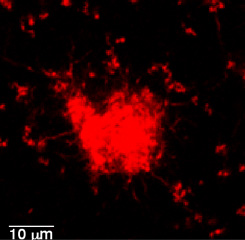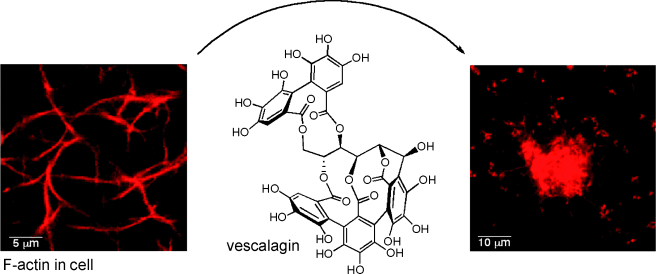| Vescalagin causes the collapse of the actin cytoskeleton |

Vescalagin causes the collapse of the actin cytoskeleton Following an internal call for proposals launched by IECB in 2007 to stimulate interdisciplinary interactions, the Génot and Quideau teams initiated a collaboration on the effect of vescalagin, an ellagitannin extracted from oak wood, upon actin. Their results, which have just been published in Angewandte Chemie International Edition, could lead to a novel therapy against osteoporosis. The two teams submitted an application to patent their discovery. On the left: Vescalagin winds actins filaments into fibrillar aggregates
3 years later, the two teams provide evidence about the ability of vescalagin to enter the cell, to bind to fibrillar actin (F-actin) without interacting with monomeric globular actin (G-actin), and to wind F-actin filaments into fribrillar aggregates without any perturbation of the microtubule network. These first results on the antiactin effect of vescalagin were released on April 27th in Angewandte Chemie International Edition.
Vescalagin thus constitutes another antiactin agent, which is capable of inhibiting the activity of certain cells by dismantling their actin cytoskeleton. The two teams now wish to use the antiactin property of vescalagin to design a new drug against osteoporosis. This degenerative disease arises when the bone cells which remove bone tissue (osteoclasts) outperform those that produce bone tissue (osteoblasts). Stéphane Quideau, Elisabeth Génot and their collaborators, who just submitted an application to patent their discovery, aim at inhibiting the activity of osteoclasts by using the antiactin property of vescalagin.
|
2, Rue Robert Escarpit - 33607 PESSAC - France
Tel. : +33 (5) 40 00 30 38 - Fax. : +33 (5) 40 00 30 68





